
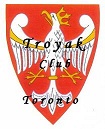
TROYAK EXECUTIVE TEAM is informing all members, colleagues, collectors, and Polonia at large, that Club meetings taking place at John Paul II Polish Cultural Centre, 4300 Cawthra Rd. (just south of Hwy. 403), Mississauga, Ontario. The new members are always welcome. www.polishculturalcentre.ca
ADRES SPOTKAÑ KLUBOWYCH ! Zarząd Główny Klubu “Troyak” informuje wszystkich członków kolekcjonerów, sympatyków oraz całą Polonię, że spotkania klubowe odbywają się w Polskim Centrum Kultury im. Jana Pawła II, przy 4300 Cawthra Rd. (na południe od autostrady 403), Mississauga, Ontario. Zapraszamy nowych członków do prężnego. Klubu “Troyak”. www.polishculturalcentre.ca

“TROYAK” CLUB NEXT MEETINGS …
NASTĘPNE SPOTKANIA KLUBU “TROYAK” …
August 2022 – Summer break … Letnie wakacje …


TROYAK CLUB @ Roncesvalles Polish Festival 2022
Saturday, 17th September 2022
Sunday, 18th September 2022

Sunday 25th September 2022 @ 4:30 p.m.

Sunday – 2nd October 2022 @ 9:00 a.m. to 4:00 p.m.
Mississauga Coin & Stamp Show
30th October 2022
27th November 2022
December 2022 … Happy Holidays!


TROYAK CLUB @ Roncesvalles Polish Festival 2022
Saturday, 17th September 2022 … Festival Hours: 11:00 am to 11:00 pm
Sunday, 18th September 2022 … Festival Hours: 11:00 am to 7:00 pm
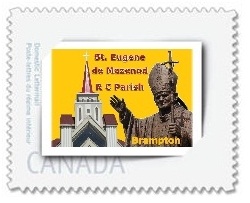
https://polishfestival.ca www.kazimierz.org
St. Casimir’s Church
Parish Hall … 156 Roncesvalles Ave. Toronto, Ontario
Stamp Exhibit … Pope John Paul II on World Stamps and
Displays of Coins, Stamps, and Collectibles by Troyak Club Members.


Roncesvalles Polish Festival 2022
https://polishfestival.ca
www.kazimierz.org
www.troyakclub.com
Roncesvalles Festival, North America’s largest celebration of Polish culture in Toronto’s best neighbourhood, Roncesvalles Village! We look forward to seeing you in September 2022. Now entering its fifteenth year, the Roncesvalles Polish Festival adds an old-world charm to today’s Roncesvalles Village, well-known as one of Toronto’s most vibrant, diverse, and creative communities.
Enjoy great local and international music, including Polish folklore, Polka and Euro dance bands, and entertainment from near and far on multiple stages. Saturday night enjoy the ever-popular Dance Under The Stars. Come out and sample fantastic cuisine from over 40 renowned restaurants, cafes, bakeries, and bistros, along Roncesvalles, and of course, lots of traditional Polish fare, including pierogi, kielbasa, bigos, cabbage rolls, and much much more!
Discover treasures along the 18 blocks of boutique shops and merchants. We also have a Car Show and many great vendors with unique products and food. The Roncesvalles Festival is easy to get to by transit and car, family-friendly and free, with lots of entertainment for kids, families, and adults, including two midway areas, three stages with continuous entertainment, two giant beverage gardens, and of course the wonderful offerings of Roncesvalles Village’s restaurants and merchants.
The Legislative Assembly of Ontario established the month of May as the Polish Heritage Month in Ontario. So-called Bill 18 was introduced as a private bill by MPP Christine Hogarth. The bill received Royal Assent on December 9, 2021, by The Honourable Elizabeth Dowdeswell.
Ontario is home to over half a million people with Polish heritage. The Polish community is one of the most numerous groups in Ontario. This great group of Canadians of Polish origin has been participating in building Canada for generations to enrich its culture and heritage and become an integral part of its multicultural community. Poles raise their children as part of the Canadian community and with respect to its values. Most Canadian families of Polish origin want to raise their descendants also in acquaintance with the language, culture, and traditions of the country of their ancestors. By proclaiming the month of May as Polish Heritage Month, the Province of Ontario recognized the great impact that Polish Canadians have had on Ontario’s history, culture, and community.
Polish Heritage Month will be celebrated each May, commemorating Constitution Day in Poland – the implementation of the first democratic and progressive constitution in Europe on May 3rd, 1791. This is one of the most important dates in Poland’s history and marks the centuries-long struggle for freedom and independence by the Polish people. Polish Heritage Month is an opportunity to bring closer to Ontarians of all ages and backgrounds Polish history and traditions. Ontario is a proud region of many cultures and proclaiming May as Polish Heritage Month is reflecting the core values of its habitants.


Muzeum Narodowe w Warszawie
National Museum in Warsaw
www.poczta-polska.pl
W dniu 20 maja 2022 r. zostały wprowadzone do obiegu 3 kartki pocztowe z nadrukowanym znakiem opłaty pocztowej, emisji: Muzeum Narodowe w Warszawie. W prawym górnym rogu strony adresowej kartek nadrukowano znaki opłaty pocztowej, na których przedstawiono: …1) na pierwszej kartce – centralną część z dziedzińcem Gmachu Głównego Muzeum Narodowego w Warszawie, 1938 r.; wzdłuż lewej krawędzi znaczka umieszczono napis: POLSKA i oznaczenie wartości: A, …2) na drugiej kartce – malowidło ścienne: św. Anna, ze zbiorów Faras, VIII w.; wzdłuż lewej krawędzi znaczka umieszczono napis: POLSKA i oznaczenie wartości: A, …3) na trzeciej kartce – obraz Józefa Mehoffera, Słońce majowe,1911 r.; wzdłuż dolnej krawędzi znaczka umieszczono napis: POLSKA i oznaczenie wartości: A.
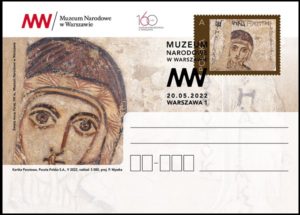
W części ilustracyjnej kartek umieszczono: …1) na pierwszej kartce – fotografię centralnej części z dziedzińcem Gmachu Głównego MNW z 1938 r oraz logo Muzeum i obchodów 160 rocznicy powstania Muzeum, …2) na drugiej kartce – fotografię malowidła ściennego Św. Anny z kolekcji Faras, VIII w. oraz logo Muzeum i obchodów 160 rocznicy powstania Muzeum …3) na trzeciej kartce – fotografię obrazu Józefa Mehoffera, Słońce majowe, 1911r. oraz logo Muzeum i obchodów 160 rocznicy powstania Muzeum.
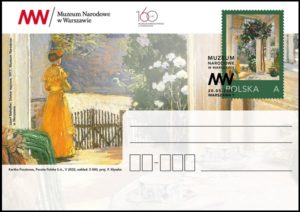
Wartość nominalna znaku opłaty pocztowej z oznaczeniem literowym A odpowiada wartości nominalnej znaczka pocztowego używanego do uiszczenia opłaty za ekonomiczną przesyłkę listową nierejestrowaną, w tym kartkę pocztową, w obrocie krajowym, w formacie S. Kartkę o wymiarach 148 x 105 mm wydrukowano jednostronnie, techniką offsetową, na kartonie białym, w nakładzie 5000 sztuk. Autor projektu kartki: Paweł Myszka.

National Museum in Warsaw … denomination: 3,60 PLN;
number of stationeries in set: 3; print run: 5.000 pcs;
printing technique: offset; card size: 148 x 105 mm;
author: Paweł Myszka; release date: 20th May 2022.

Polacy na Syberii
Poles in Siberia
www.poczta-polska.pl
W dniu 23 maja 2022 r. został wprowadzony do obiegu znaczek pocztowy o wartości 3,60 zł emisji “Polacy na Syberii”. Znaczek wydrukowano techniką rotograwiurową, na papierze fluorescencyjnym, format znaczka: 31,25 x 39,5 mm , w nakładzie 120.000 szt. Arkusz sprzedażny zawiera 50 szt. znaczków. Z tej okazji została wydana również koperta FDC. Na znaczku przedstawiono postać Aleksandra Czekanowskiego (1833-1876) – zesłańca (za udział w Powstaniu Styczniowym), geologa, geografa, podróżnika, badacza Syberii (okolice Jeziora Bajkał, Ląd Angary, górny bieg Dolnej Tunguzki, wyprawa przez Oleniok, południowy bieg Leny). Nad doliną Tunguzką odkrył pokłady węgla i grafitu. Na znaczku portret – drzeworyt wykonany przez Aleksandra Regulskiego na podstawie rysunku autorstwa Franciszka Tegazzo. Na kopercie FDC widnieje bieg rzeki Leny z zaznaczonymi miejscowościami – mapa wykonana przez A. Czekanowskiego w 1875 r. Datownik – grafika z muszlą (A. Czekanowski zebrał ok. 4 tys. okazów paleontologicznych, 18 tys. zoologicznych, 9 tys. botanicznych). Autor projektu: Jarosław Ochendzan.

Poles in Siberia … denomination: 3,60 PLN;
number of stamps in set: 1; 50 stamps in sheet;
print run: 120.000 pcs.; paper: fluorescent;
printing techniques: photogravure;
stamp size: 31,25 x 39,5 mm; number of FDC: 1;
author: Jarosław Ochendzan;
circulation date: 23rd May 2022.

100-lecie Akademii Pedagogiki Specjalnej
im. Marii Grzegorzewskiej w Warszawie
100 Years of Maria Grzegorzewska Academy
of Special Education in Warsaw
www.poczta-polska.pl
W dniu 25 maja 2022 r. została wprowadzona do obiegu kartka pocztowa z nadrukowanym znakiem opłaty pocztowej, emisji: 100-lecie Akademii Pedagogiki Specjalnej im. Marii Grzegorzewskiej w Warszawie. Wartość nominalna znaku opłaty pocztowej z oznaczeniem literowym A odpowiada wartości nominalnej znaczka pocztowego używanego do uiszczenia opłaty za ekonomiczną przesyłkę listową nierejestrowaną, w tym kartkę pocztową, w obrocie krajowym, w formacie S.
W prawym górnym rogu strony adresowej kartki nadrukowano znak opłaty pocztowej, na którym przedstawiono wizerunek Marii Grzegorzewskiej; w prawym górnym rogu znaczka umieszczono oznaczenie wartości: A oraz napis: POLSKA; w polu przywieszki przestawiono współczesny widok budynku Akademii Pedagogiki Specjalnej im. Marii Grzegorzewskiej w Warszawie. W części ilustracyjnej kartki umieszczono: fragment budynku Państwowego Instytutu Pedagogiki Specjalnej w Warszawie, logo obchodów stulecia uczelni: ,,100″, widok rękopisów Marii Grzegorzewskiej, stronę tytułową publikacji Marii Grzegorzewskiej ,,Szkoła Specjalna” i ,,Listy do Młodego Nauczyciela” oraz tekst: ,,100-lecie Akademii Pedagogiki Specjalnej im. Marii Grzegorzewskiej w Warszawie 1922-2022, The Maria Grzegorzewska University 1922-2022″.
Emisja realizowana na wniosek Akademii Pedagogiki Specjalnej im. Marii Grzegorzewskiej w Warszawie na bazie materiałów udostępnionych przez APS w Warszawie. Przypadające w 2022 roku 100-lecie ASP zbiega się ustanowieniem przez Sejm roku 2022 Rokiem Marii Grzegorzewskiej. Kartkę o wymiarach 148 x 105 mm wydrukowano jednostronnie, techniką offsetową, na kartonie białym, w nakładzie 5000 sztuk. Autor projektu kartki: Jan Konarzewski.
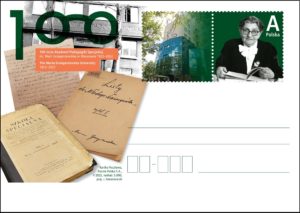
100 Years of Maria Grzegorzewska Academy of Special Education in Warsaw … denomination: 3,60 PLN; number of stationeries in set: 1; print run: 5.000 pcs; printing technique: offset; card size: 148 x 105 mm; author: Jan Konarzewski; release date: 25th May 2022.

Maria Wittek – pierwsza kobieta generał w Wojsku Polskim
Maria Wittek – the first woman general in the Polish Army
www.poczta-polska.pl
W dniu 30 maja 2022 r. została wprowadzona do obiegu kartka pocztowa z nadrukowanym znakiem opłaty pocztowej, emisji: Maria Wittek – pierwsza kobieta generał w Wojsku Polskim. Wartość nominalna znaku opłaty pocztowej z oznaczeniem literowym A odpowiada wartości nominalnej znaczka pocztowego używanego do uiszczenia opłaty za ekonomiczną przesyłkę listową nierejestrowaną, w tym kartkę pocztową, w obrocie krajowym, w formacie S.
W prawym górnym rogu strony adresowej kartki nadrukowano znak opłaty pocztowej, na którym umieszczono zdjęcie oryginalnego, należącego do Marii Wittek orderu Virtuti Militari. Wzdłuż lewej krawędzi znaczka umieszczono napis: POLSKA, w lewym górnym rogu oznaczenie wartości: A. W części ilustracyjnej kartki umieszczono zdjęcie gen. Marii Wittek na tle szkicu budynku Archiwum Akt Nowych, w którym znajdują się zbiory utworzonej przez gen. Marię Wittek Komisji Historii Kobiet w Walce o Niepodległość Polski. W grafice datownika wykorzystano pattern taśmy generalskiej. Projekt emisji powstał w ścisłej współpracy z Archiwum Akt Nowych. Kartkę o wymiarach 148 x 105 mm wydrukowano jednostronnie, techniką offsetową, na kartonie białym, w nakładzie 5000 sztuk. Autor projektu kartki: Poczta Polska S.A.

Maria Wittek – the first woman general in the Polish Army …
denomination: 3,60 PLN; number of stationeries in set: 1;
print run: 5.000 pcs; printing technique: offset;
card size: 148 x 105 mm; author: Poczta Polska S.A.;
release date: 30th May 2022.

50 lat komiksu Kajko i Kokosz
50 Years of Kajko and Kokosz Comics
www.poczta-polska.pl
W dniu 31 maja 2022 r. został wprowadzony do obiegu znaczek pocztowy w formie bloku o wartości 8,00 zł, emisji “50 lat komiksu Kajko i Kokosz”. Na znaczku przedstawiono postacie Kajka i Kokosza oraz Milusia, bohaterów komiksu autorstwa Janusza Christy. Znaczek wydrukowano techniką offsetową, na papierze fluorescencyjnym, w formacie: format znaczka: 31,25 x 43 mm , format bloku: 90 x 70 mm. Nakład: – wersja perforowana – 90 000 sztuk – wersja nieperforowana – 6 000 sztuk. Z tej okazji została wydana również koperta FDC. Autorzy projektu: Joanna Fleszar-Haspert, Radosław Gieremek.
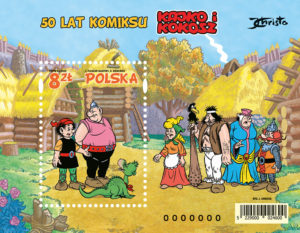
50 Years of Kajko and Kokosz Comics … denomination: 8,00 PLN; number of stamps in set: 1; print run: 90.000 pcs perforated and 6.000 pcs unperforated; printing techniques: offset; paper: fluorescent; stamp size: 31,25 x 43 mm, block size: 90 x 70 mm; number of FDC: 1; authors: Joanna Fleszar-Haspert, Radosław Gieremek; circulation date: 31st May 2022.

Jubileusze Papieskich Dzieł Misyjnych
Jubilees of the Pontifical Mission Societies
www.poczta-polska.pl
W dniu 3 czerwca 2022 zostały wprowadzone do obiegu trzy znaczki pocztowe o wartości 4,50 zł każdy, emisji “Jubileusze Papieskich Dzieł Misyjnych”. W 2022 roku przypada kilka jubileuszy związanych z Papieskimi Dziełami Misyjnymi, m.in. 400-lecie powołania do życia Kongregacji Ewangelizacji Narodów, 200-lecie powstania Dzieła Rozkrzewiania Wiary, 100-lecie podniesienia Dzieła Rozkrzewiania Wiary, Dzieł św. Piotra Apostoła i Dzieła Misyjnego Dzieci do rangi dzieł papieskich oraz 150. rocznicy urodzin bł. Pawła Manny, założyciela Papieskiej Unii Misyjnej. 22 maja 2022 r. w Lyonie zostanie beatyfikowana Paulina Jaricot (1799-1862), założycielka Dzieła Rozkrzewiania Wiary i Żywego Różańca – stąd opis na rekomendowanym znaczku jest już ze skrótem “Bł.”
Na znaczkach obu projektów przedstawiono założycieli poszczególnych Dzieł: …1. Bp Karol de Forbin-Janson (1785-1844) – twórca Dzieła Misyjnego Dzieci. Francuski biskup, który zwrócił się do dzieci z prośbą, by zaangażowały się w pomoc rówieśnikom w Chinach. …2. Joanna Bigard (1859-1934) – inicjatorka Dzieła św. Piotra Apostoła. Świecka kobieta, która wraz z matką troszczyła się o powołania w krajach misyjnych. …3. Bł. Paulina Jaricot (1799-1862) – założycielka Dzieła Rozkrzewiania Wiary i Żywego Różańca. Francuzka, która poświęciła całe życie, swoje talenty i dobre pochodzenie dziełu ewangelizacji.
Na oprawie bloku znajduje się również herb/logotyp Papieskich dzieł Misyjnych. Na kopercie FDC … historyczna mapa świata. Znaczki wydrukowano techniką rotograwiurową, na papierze fluorescencyjnym, format znaczków: 40,5 x 54 mm każdy , format bloku: 158 x 104 mm , w nakładzie 100.000 szt każdego. Z tej okazji została wydana koperta FDC. Autor projektu: Agnieszka Sancewicz.
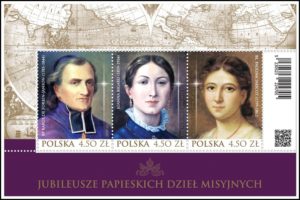
Jubilees of the Pontifical Mission Societies… denomination: 4,50 PLN of each; number of stamps in set: 3; print run: 100 000 pcs of each; printing techniques: rotogravure; paper: fluorescent; stamp size: 40,5 x 54 mm; block size: 158 x 104 mm; number of FDC: 1; author: Agnieszka Sancewicz; circulation date: 3rd June 2022.

Jan Olszewski
www.poczta-polska.pl
W dniu 4 czerwca 2022 r. został wprowadzony do obiegu znaczek pocztowy o wartości 4,50 zł emisji “Jan Olszewski”. Na znaczku pocztowym – grafik przedstawił zdjęcie Jana Olszewskiego na tle barw biało-czerwonych, a w tle budynek Sejmu. Na kopercie FDC znajduje się budynek Sejmu i flaga Polski. Na datowniku przedstawione jest faksymile Jana Olszewskiego.
Wnioskodawcą był Robert Gut, Prezes Zarządu Fundacji Rozwoju Gospodarczego im. kpt. ż. w. inż. Zbigniewa Sulatyckiego. Znaczek wydrukowano techniką rotograwiurową, na papierze fluorescencyjnym, format znaczka: 31,25 x 39,5 mm , w nakładzie 100.000 szt. Arkusz sprzedażny zawiera 50 szt. znaczków. Z tej okazji została wydana również koperta FDC. Autor projektu: Poczta Polska S.A.

Jan Olszewski … denomination: 4,50 PLN; number of stamps in set: 1; 50 stamps in sheet; print run: 100.000 pcs.; paper: fluorescent; printing techniques: photogravure; stamp size: 31,25 x 39,5 mm; number of FDC: 1; author: Poczta Polska S.A.; circulation date: 4th June 2022.

30. Rocznica utworzenia diecezji elbląskiej
30th Anniversary of the Establishment of the Diocese of Elbląg
www.poczta-polska.pl
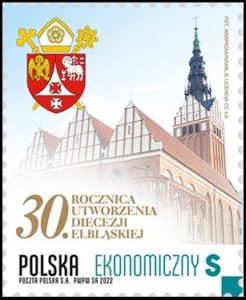
W dniu 6 czerwca 2022 został wprowadzony do obiegu znaczek pocztowy o wartości odpowiadającej opłacie za list ekonomiczny krajowy w formacie S emisji “30. rocznica utworzenia diecezji elbląskiej”. Na znaczku przedstawiono zdjęcie Katedry św. Mikołaja w Elblągu oraz herb diecezji Elbląskiej. Znaczek wydrukowano techniką rotograwiurową, na papierze fluorescencyjnym w formacie 25,5 x 31,25 mm, w nakładzie wielomilionowym, powtarzalnym. Arkusz sprzedażny zawiera 100 znaczków. Z tej okazji została wydana również koperta FDC. Autor projektu: Jarosław Ochendzan.
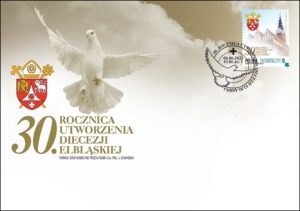
30th Anniversary of the Establishment of the Diocese of Elbląg … denomination: 3,60 PLN; number of stamps in set: 1; 100 pcs in sheet; print run:multi million pcs.; printing techniques: photogravure; paper: fluorescent; stamp size: 25,5 x 31,25 mm; number of FDC: 1; author: Jarosław Ochendzan; circulation date: 6th June 2022.

100. Rocznica utworzenia policji województwa śląskiego
100th Anniversary of the Police of the Silesian Province
www.poczta-polska.pl
W dniu 9 czerwca 2022 został wprowadzony do obiegu znaczek pocztowy o wartości odpowiadającej opłacie za list ekonomiczny krajowy w formacie S emisji “100. rocznica utworzenia policji województwa śląskiego”. Na znaczku przedstawiono formę odnoszącą się do odznaki pamiątkowej Policji Województwa Śląskiego oraz orła, nawiązującego do historycznego herbu województwa śląskiego i napis: 100. ROCZNICA UTWORZENIA POLICJI WOJEWÓDZTWA ŚLĄSKIEGO. Wzdłuż dolnej krawędzi umieszczono napis: POLSKA i oznaczenie: EKONOMICZNY S, co odpowiada wartości nominalnej znaczka pocztowego właściwego do uiszczenia opłaty za ekonomiczną przesyłkę listową nierejestrowaną w obrocie krajowym w formacie S i ekonomiczną kartkę pocztową w obrocie krajowym.
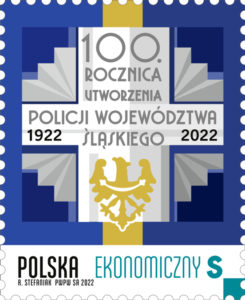
Znaczek wydrukowano techniką rotograwiurową, na papierze fluorescencyjnym, w formacie 25,5 x 31,25 mm, w nakładzie wielomilionowym, powtarzalnym. Arkusz sprzedażny zawiera 100 znaczków. Z tej okazji została wydana również koperta FDC.
Na kopercie FDC przedstawiono: Uroczysty apel z okazji trzeciej rocznicy utworzenia Policji Województwa Śląskiego na terenie Komendy Rezerwy w Katowicach. Rok 1925. źródła fotografii: Archiwum przy Zarządzie Ogólnopolskiego Stowarzyszenie Rodzina Policyjna 1939 r. z/s w Katowicach oraz w lewym dolnym rogu koperty znajduje się logo Stowarzyszenia “Rodzina Policyjna 1939”. Grafika na znaczek, kopertę i datownik była konsultowana z Ogólnopolskim Stowarzyszeniem “Rodzina Policyjna 1939”. Autor projektu: Roch Stefaniak.
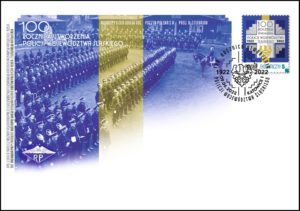
100th Anniversary of the Police of the Silesian Province … denomination: 3,60 PLN; number of stamps in set: 1; 100 pcs in sheet; print run:multi million pcs.; printing techniques: photogravure; paper: fluorescent; stamp size: 25,5 x 31,25 mm; number of FDC: 1; author: Roch Stefaniak; circulation date: 9th June 2022.

Boże Ciało w Spycimierzu
Corpus Christi procession in Spycimierz
www.poczta-polska.pl
W dniu 15 czerwca 2022 r. została wprowadzona do obiegu kartka pocztowa z nadrukowanym znakiem opłaty pocztowej, emisji: Boże Ciało w Spycimierzu. Wartość nominalna znaku opłaty pocztowej z oznaczeniem literowym A odpowiada wartości nominalnej znaczka pocztowego używanego do uiszczenia opłaty za ekonomiczną przesyłkę listową nierejestrowaną, w tym kartkę pocztową, w obrocie krajowym, w formacie S. W prawym górnym rogu strony adresowej kartki nadrukowano znak opłaty pocztowej, na którym umieszczono zdjęcie z lotu ptaka spycimierskiego dywanu kwiatowego. W prawym górnym rogu umieszczono napis: POLSKA, a pod nim oznaczenie wartości: A.
W części ilustracyjnej kartki umieszczono zdjęcie procesji Bożego Ciała w Spycimierzu idącej po dywanie kwiatowym. Spycimierska tradycja układania wielokilometrowych dywanów kwiatowych, po których przechodzi procesja Bożego Ciała ma 200 lat i została wpisana na Listę reprezentatywną niematerialnego dziedzictwa kulturowego ludzkości UNESCO. W grafice datownika wykorzystano element oficjalnego logotypu Spycimierskiego Bożego Ciała. Projekt powstał we współpracy z Urzędem Miasta w Uniejowie. Kartkę o wymiarach 148 x 105 mm wydrukowano jednostronnie, techniką offsetową, na kartonie białym, w nakładzie 5000 sztuk. Autor projektu kartki: Poczta Polska S.A.
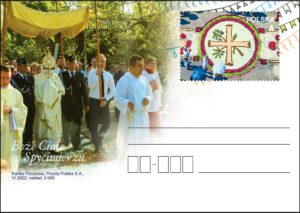
Corpus Christi procession in Spycimierz … denomination: 3,60 PLN; number of stationeries in set: 1; print run: 5.000 pcs; printing technique: offset; card size: 148 x 105 mm; author: Poczta Polska S.A.; release date: 15th June 2022.

30. Rocznica powołania Straży Granicznej
www.nbp.pl
Narodowy Bank Polski jest centralnym bankiem państwa odpowiadającym za politykę pieniężną i stabilność cen. Jego funkcje określa Konstytucja Rzeczypospolitej Polskiej i ustawa o NBP. NBP ma wyłączne prawo emisji pieniądza. Jako bank centralny nie prowadzi rachunków bankowych obywateli, nie przyjmuje od nich lokat, nie udziela kredytów. Prowadzi natomiast obsługę budżetu państwa, a także podmiotów sektora finansów publicznych. Gromadzi rezerwy walutowe państwa i zarządza nimi. Pełni funkcję banku banków, tworząc warunki do działania systemu bankowego. Jest również jednym z najważniejszych ośrodków naukowo-analitycznych w dziedzinie ekonomii i rynków finansowych.
Emisja wartości kolekcjonerskich stanowi okazję do upamiętniania ważnych historycznych rocznic i postaci oraz do rozwijania zainteresowań polską kulturą, nauką i tradycją. 11 maja 2022 roku Narodowy Bank Polski wprowadził do obiegu srebrną monetę o nominale 10 zł „30. rocznica powołania Straży Granicznej”.

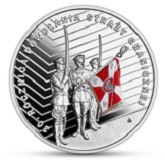
Nominał 10 zł … metal: Ag 925/1000; stempel: lustrzany, druk UV; średnica: 32,00 mm; masa: 14,14 g; brzeg (bok): gładki; nakład: do 12 000 szt.; Projektant: Sebastian Mikołajczak; Emitent: NBP; Na zlecenie NBP monety wyprodukowała Mennica Polska S.A. Na rewersie monety umieszczono wizerunek funkcjonariuszy Straży Granicznej występujących w składzie pocztu sztandarowego ze sztandarem Komendy Głównej Straży Granicznej. Awers monety przedstawia funkcjonariusza Straży Granicznej z psem podczas patrolu.
Straż Graniczna (SG) to umundurowana i uzbrojona formacja powołana do ochrony polskiej granicy. 16 maja 1991 r. objęła służbę na granicy Polski. Od 30 lat tego dnia obchodzone jest święto wszystkich funkcjonariuszy i pracowników SG. Straż Graniczna w swoich działaniach sięga do chlubnych tradycji formacji granicznych tworzonych po odzyskaniu przez Polskę niepodległości w 1918 r. Ze szczególnym poważaniem kultywuje tradycje Korpusu Ochrony Pogranicza (1924–1939), specjalnej organizacji wojskowej utworzonej w celu zapewnienia ochrony przed radziecką dywersją na Kresach Wschodnich, oraz Straży Granicznej (1928–1939), działającej na granicy zachodniej półwojskowej formacji, której funkcjonariusze z narażeniem życia zwalczali przemytnictwo podczas polsko-niemieckiej wojny celnej.
1 września 1939 r. żołnierze SG jako pierwsi stanęli do walki z niemieckim najeźdźcą, a 17 września żołnierze KOP walczyli z radzieckim agresorem. Współczesna Straż Graniczna jest scentralizowaną formacją podległą Ministrowi Spraw Wewnętrznych i Administracji. Do jej zadań należą ochrona granicy państwowej na lądzie i morzu, organizowanie i dokonywanie kontroli na przejściach granicznych, zapobieganie i przeciwdziałanie nielegalnej migracji, weryfikacja przestrzegania przepisów wjazdu i pobytu cudzoziemców, wykrywanie i ściganie sprawców przestępstw związanych z przekraczaniem granicy, w tym z materiałami wybuchowymi, bronią i amunicją, narkotykami i środkami odurzającymi, a także zabytkami sztuki. Straż Graniczna zajmuje się zapewnieniem bezpieczeństwa w komunikacji międzynarodowej oraz współdziałaniem z uprawnionymi organami i służbami w zakresie wykrywania zagrożeń terrorystycznych, realizuje również zadania wynikające z przepisów prawa Unii Europejskiej oraz porozumień międzynarodowych.
Jako jedyna formacja jest uprawniona do bezpośredniej ochrony polskiej granicy o długości 3511 km (w tym 440 km granicy morskiej), przy czym aż 1581 km to granica zewnętrzna Unii Europejskiej. Funkcjonariusze pełnią też służbę migracyjną i zwalczają zorganizowaną przestępczość przemytniczą na całym terytorium Polski. Służba w SG jest dobrowolna. Mogą ją pełnić osoby pełnoletnie, mające wyłącznie obywatelstwo polskie, o nieposzlakowanej opinii, niekarane, korzystające w pełni z praw publicznych, posiadające zdolność fizyczną i psychiczną do służby w formacjach uzbrojonych, podlegających szczególnej dyscyplinie, a także dające rękojmię zachowania tajemnicy. Każdy funkcjonariusz SG w sposób uroczysty ślubuje m.in. „służyć wiernie Narodowi Polskiemu, mając zawsze na względzie interes Państwa Polskiego” i „stać nieugięcie na straży niepodległości i suwerenności oraz strzec nienaruszalności granicy państwowej Rzeczypospolitej Polskiej, nawet z narażeniem życia”. Według stanu na dzień 31 stycznia 2022 r. służbę w Straży Granicznej pełniło 14 814 funkcjonariuszy, w tym 4375 (29,5%) kobiet. Zdecydowana większość pełni ją w bezpośredniej ochronie granicy lub kontroli ruchu granicznego. mjr SG dr Artur Ochał.

30th Anniversary of the Establishment
of the Polish Border Guard
www.nbp.pl
Narodowy Bank Polski is the central bank of the State, responsible for its monetary policy and price stability. The Bank’s functions are described in the Constitution of the Republic of Poland and the Act on NBP. NBP holds the exclusive right to issue the currency of the Republic of Poland. As the central bank, it does not provide accounts for the general public, accept deposits from or extend loans to individuals. It acts as a banker to the State budget and public sector entities. NBP also holds and manages the foreign exchange reserves of the State. Finally, it functions as a banker to banks, creating conditions for the operation of the Polish banking system. Narodowy Bank Polski is one of the most important research and analytical centres in the fields of economics and financial markets.
Issuing collector items is an occasion to commemorate important historic figures and anniversaries, as well as to develop the interest of the public in Polish culture, science, and tradition. On 11 May 2022, Narodowy Bank Polski issued into circulation a silver coin “30th Anniversary of the Establishment of the Polish Border Guard”, with a face value of 10 złoty.


Face value: 10 zł … Metal: Ag 925/1000; Finish: proof, UV printing; Diameter: 32.00 mm; Weight: 14.14 g; Edge (side): plain; Mintage: up to 12,000 pcs; Designer: Sebastian Mikołajczak; Issuer: NBP; The coins, commissioned by NBP, were struck by Mennica Polska S.A. The reverse of the coin features officers forming the colour guard of the standard of the Polish Border Guard National Headquarters. The obverse of the coin features a Polish Border Guard officer with a dog on a patrol.
The Polish Border Guard is a uniformed and armed service established to protect the Polish border. It was first deployed on 16 May 1991. For 30 years this day has been celebrated as a holiday of all the officers and employees of the Polish Border Guard. While performing its duties, the Polish Border Guard follows the glorious traditions of the border formations created after Poland had regained its independence in 1918. With particular respect, it cultivates the traditions of the Border Protection Corps (1924-1939), a special military organization created to provide protection against Soviet sabotage in the Eastern Borderlands, and the Border Guard (1928-1939), a semi-military formation operating on the western border, whose officers risked their lives combating smuggling during the PolishGerman tariff war.
On 1 September 1939, the soldiers of the Border Guard were the first to fight against the German invaders, while on 17 September the soldiers of the Border Protection Corps were the first line of Poland’s defense against the Soviet aggressor. The contemporary Polish Border Guard is a centralized administrative body within the Ministry of the Interior and Administration. Its tasks include the protection of the state border both on land and at sea, organizing and conducting checks at border crossing points, preventing and counteracting illegal migration (e.g. by verifying compliance with the rules of entry and stay of foreigners), and detection and prosecution of perpetrators of crimes related to the border crossing (e.g.those involving explosives, arms and ammunition, drugs and narcotics, and works of art). The Polish Border Guard ensures the safety of international transport, cooperates with authorized bodies and services in the domain of terrorist threat detection, and performs tasks arising from the regulations of the European Union law and international agreements.
The Polish Border Guard is the only armed service authorized to protect directly the 3,511 km long Polish border (including 440 km of sea border), of which as much as 1,581 km is the external border of the European Union. The officers also perform migration duties and combat organized smuggling across the entire territory of Poland. Service in the Polish Border Guard is voluntary. It can be done by adults, exclusively of Polish citizenship, with a good reputation, with no criminal record, enjoying full public rights, having the physical and mental capacity to serve in the armed forces, subject to special discipline, and also providing a guarantee of confidentiality. Each officer of the Polish Border Guard solemnly swears “to serve the Polish Nation faithfully, always taking into account the interest of the State of Poland” and “to guard with determination the independence and sovereignty of the Republic of Poland and to secure the inviolability of the State border, even at the risk of life”. As of 31 January 2022, 14,814 officers served in the Polish Border Guard, including 4,375 (29.5%) women. The vast majority of officers perform their duties in direct border protection or border traffic control. Info: Polish Border Guard Major, Artur Ochał, Ph.D.

Odkryj Polskę – Zamek w Mosznej
www.nbp.pl
Narodowy Bank Polski jest centralnym bankiem państwa odpowiadającym za politykę pieniężną i stabilność cen. Jego funkcje określa Konstytucja Rzeczypospolitej Polskiej i ustawa o NBP. NBP ma wyłączne prawo emisji pieniądza. Jako bank centralny nie prowadzi rachunków bankowych obywateli, nie przyjmuje od nich lokat, nie udziela kredytów. Prowadzi natomiast obsługę budżetu państwa, a także podmiotów sektora finansów publicznych. Gromadzi rezerwy walutowe państwa i zarządza nimi. Pełni funkcję banku banków, tworząc warunki do działania systemu bankowego. Jest również jednym z najważniejszych ośrodków naukowo-analitycznych w dziedzinie ekonomii i rynków finansowych.
Emisja wartości kolekcjonerskich stanowi okazję do upamiętniania ważnych historycznych rocznic i postaci oraz do rozwijania zainteresowań polską kulturą, nauką i tradycją. 23 maja 2022 roku Narodowy Bank Polski wprowadził do obiegu monetę okolicznościową o nominale 5 zł z serii „Odkryj Polskę” – „Zamek w Mosznej”.
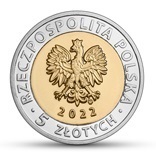
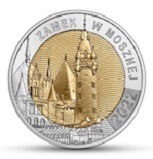
Nominał 5 zł … stop: pierścień MN25, rdzeń CuAl6Ni2; stempel: zwykły; średnica: 24,00 mm; masa: 6,54 g; brzeg (bok): moletowany nieregularnie; na boku ośmiokrotnie powtórzony napis: NBP, co drugi odwrócony o 180 stopni, rozdzielony gwiazdkami; nakład: do 1 000 000 szt.; Projektant awersu: Dobrochna Surajewska; Projektant rewersu: Paweł Pietras; Emitent: NBP; Na zlecenie NBP monety wyprodukowała Mennica Polska S.A.
Zamek w Mosznej na Górnym Śląsku to rezydencja położona 30 km od Opola. Jest niezwykłą budowlą, wzniesioną w XVII w. przez rodziny pruskie, a swoją sławę zawdzięcza bajkowej architekturze – ma 365 pomieszczeń, 99 wież i wieżyczek. Pierwsze wzmianki o miejscowości Moszna pojawiają się już w „Księdze henrykowskiej”, w części datowanej mniej więcej na 1310 r. Fantazyjny architektonicznie, eklektyczny pałac z przylegającą do rezydencji oranżerią pełną egzotycznych roślin jest otoczony rozległym, 200-hektarowym parkiem krajobrazowym z wielowiekowymi dębami, wpisanymi do rejestru zabytków przyrody. Przez wiele lat zamek zmieniał właścicieli i był przebudowywany według różnych stylów. W końcu trafił w ręce jednej z najbogatszych rodzin tej części Europy – von Tiele-Wincklerów, i to jej zawdzięcza ostateczny wygląd, styl wnętrz i swój urok. Rezydencja rozbudowywana z rozmachem po pożarze w 1896 r. uzyskała bardzo zróżnicowany stylowo kształt, który obecnie zaskakuje bogactwem zdobień i rzeźb. Bryła zamku i układ wnętrz zostały zaprojektowane przez architektów berlińskich, m.in. Wilhelma Kimbela, znanego specjalistę od wnętrz nowoczesnych.
Właściciel Franz Hubert von Tiele-Winckler także wielokrotnie modyfikował projekty. Z myślą o wygodzie Wilhelma II, cesarza Niemiec i króla Prus, który bywał gościem polowań w dobrach von Tiele-Wincklerów, dobudowano skrzydło zachodnie pałacu. Właściciel i architekci postanowili, że tzw. Pokój Pana wykonany w stylu eklektycznym będzie stanowić najważniejsze miejsce w zamku. Obok powstała kaplica o znakomitej akustyce. Zachował się witraż z 1900 r. z pracowni M. Luthiego z Monachium. W czasie II wojny światowej Armia Czerwona stacjonująca na zamku dokonała znaczących spustoszeń w jego wnętrzach. Znaczna część wyposażenia pałacowego została zdewastowana, a większość przechowywanych tam dzieł sztuki, głównie obrazów i rzeźb, wywieziona. Po wojnie meble i sprzęty zrabowano, pozostały jedynie trwałe elementy wystroju.
Obiekt nie popadł w ruinę, stanowił siedzibę różnych instytucji, m.in. sanatorium. Obecnie kompleks pałacowo-parkowy pełni funkcję ośrodka konferencyjnego i hotelowego, w kaplicy odbywają się koncerty muzyki kameralnej, a w galerii wystawy dzieł sztuki. Do zamku prowadzi aleja dębowa, której najstarsze drzewa liczą 300 lat. W parku znajduje się staw z wysepką oraz prowadzącym do niej mostkiem w stylu chińskim. Niedaleko zamku jest cmentarz z grobowcami przedstawicieli rodu wcześniejszych właścicieli. W dawnych zabudowaniach folwarcznych działa stadnina odnosząca światowe sukcesy w hodowli koni szlachetnej półkrwi. Rewers monety 5 zł z serii „Odkryj Polskę” – „Zamek w Mosznej” przedstawia bryłę zamku z wieżami, z widocznymi detalami fasady. Informacja: Prof. Juliusz A. Chrościcki.

Discover Poland – Moszna Castle
www.nbp.pl
Narodowy Bank Polski is the central bank of the State, responsible for its monetary policy and price stability. The Bank’s functions are described in the Constitution of the Republic of Poland and the Act on NBP. NBP holds the exclusive right to issue the currency of the Republic of Poland. As the central bank, it does not provide accounts for the general public, accept deposits from or extend loans to individuals. It acts as a banker to the State budget and public sector entities. NBP also holds and manages the foreign exchange reserves of the State. Finally, it functions as a banker to banks, creating conditions for the operation of the Polish banking system. Narodowy Bank Polski is one of the most important research and analytical centres in the fields of economics and financial markets.
Issuing collector items is an occasion to commemorate important historic figures and anniversaries, as well as to develop the interest of the public in Polish culture, science, and tradition. On 23 May 2022, Narodowy Bank Polski issued into circulation a commemorative coin of the series “Discover Poland” – “Moszna Castle”, with a face value of 5 złoty.


Face value: 5 zł … Metal: ring MN25, core CuAl6Ni2; Finish: standard; Diameter: 24.00 mm; Weight: 6.54 g; Edge (side): irregularly milled, with the inscription “NBP”, repeated eight times, every second one inverted by 180 degrees, separated by stars; Mintage: up to 1,000,000 pcs; Obverse designer: Dobrochna Surajewska; Reverse designer: Paweł Pietras; Issuer: NBP; The coins, commissioned by NBP, were struck by Mennica Polska S.A.
The Castle in Moszna in Upper Silesia is a residence located approximately 30 km from Opole. This extraordinary building, erected in the 17th century by Prussian families, is famous for its amazing fairy-tale architecture with 365 rooms, as well as 99 towers and turrets. The first mention of the town of Moszna appeared in Księga henrykowska [Book of Henryków], in the part dated around 1310. The architecturally fanciful, eclectic palace – with an orangery full of exotic plants adjacent to the residence – is surrounded by a vast, 200-hectare landscape park with centuries-old oak trees entered in the register of natural monuments. For many years, the castle’s ownership changed frequently, and it was repeatedly rebuilt in various architectural styles. It ultimately came into the hands of one of the wealthiest dynasties in this part of Europe – the von Tiele-Winckler family, which became responsible for its final appearance, interior decoration style, and undeniable charm. The residence, which was expanded on a grand scale following a fire in 1896, obtained a stylistically diverse structure, which now surprises visitors with its wealth of ornamentation and sculptures. The main body of the castle and the interior layouts were designed by Berlin-based architects, including Wilhelm Kimbel, a well-known specialist in modern interiors.
The building’s owner, Franz Hubert von Tiele-Winckler, also repeatedly modified the designs. The west wing of the palace was added in order to provide comfortable accommodation to Wilhelm II, the Emperor of Germany, and the King of Prussia, who used to participate in hunts organized at von TieleWinckler’s estate. The owner and architects decided that the so-called Lord’s Room, executed in an eclectic architectural style, would be the most prominent place in the castle. A chapel with excellent acoustics was built right next to it. Within it, a stained-glass window from 1900, executed by the workshop of M. Luthi from Munich, has been preserved to this day. During World War II, the Red Army was stationed at the castle, causing considerable damage to its interior. A large part of the palace furnishings was destroyed, and most of the works of art stored there, which mainly included paintings and sculptures, were looted. After the war, the furniture and appliances were stolen, and only the permanently affixed elements of the interior decor remained. The building did not fall into ruin, however, and served as the seat of various institutions, including a sanatorium.
Currently, the palace and park complex serves as a conference and hotel centre, while chamber music concerts are held at the chapel, and art exhibitions are organized at the gallery. The oldest trees in the oak alley leading to the castle are 300 years old. In the park, there is a pond with an island and a Chinese-style bridge. Near the castle, there is a cemetery with the tombs of people from the family of its previous owners. In the buildings of the former farm estate, there is a new stud farm facility that is globally renowned for breeding noble half-blood horses. The reverse side of the 5 zł coin from the series “Discover Poland” – “Moszna Castle” shows the main body of the castle with towers, along with visible details of the facade. Info: Prof. Juliusz A. Chrościcki.


Salome BEY
www.canadapost.ca
This booklet of 6 PermanentTM domestic rate stamps celebrates the life and work of Salome Bey, known as Canada’s “first lady of the blues.” The Grammy-nominated singer-songwriter was an inspiration and mentor for many young Black artists throughout her celebrated career. She is an honorary member of the Order of Canada. The stamp features an illustration by David Belliveau of Salome during her performing years. It’s based on a photo by Doug Griffin.
Born in New Jersey, Salome began her musical career with her brother and sister. Billed as Andy and the Bey Sisters, the siblings toured Europe and North America. In 1964, Salome moved to Toronto, where her popularity on the jazz club circuit earned her the moniker Canada’s “first lady of the blues.” Salome also saw success on the stage. She appeared in the Broadway musical Your Arms Too Short to Box with God, which earned her and other performers a Grammy nomination for their work on the cast album. A member of the Canadian charity Artists Against Racism, Salome created many opportunities for Black performers. In 1996, she received the Dr. Martin Luther King Jr. Achievement Award.

Stamp Designer: Paprika; Stamp Illustrator: David Belliveau; Illustration based on photo by Doug Griffin | Toronto Star | Getty Images; Stamp Value: Permanent™ domestic rate; Quantity Produced: 150,000; Issue Date April 22, 2022.

This Official First Day Cover (OFDC) celebrates the life and work of Salome Bey, known as Canada’s “first lady of the blues.” The OFDC features a photo by Annette Clough of Salome during her performing years and an image of the stamp. David Belliveau illustrated the stamp based on a photo of Salome. The cancel location is Toronto, where Salome’s popularity on the jazz club circuit earned her the moniker Canada’s “first lady of the blues.” Quantity Produced 7,000; Issue Date April 22.


Help for Ukraine: PermanentTM domestic rate stamps –
booklet of 10 + $1 donation
www.canadapost.ca
This booklet of 10 PermanentTM domestic rate stamps is offered to our customers as a means of supporting humanitarian aid in Ukraine. A donation of $1 from each booklet of 10 stamps will go directly to the Canada-Ukraine Foundation. The stamp features a sunflower – the national flower of Ukraine. It has become a symbol of peace and unity. The bright yellow flower, which has deep meaning for Ukrainians, can be seen throughout the country, including as adornment in the vinok, the traditional floral headdress. The yellow sunflower is shown against a blue-sky background, reflecting the country’s flag colours of yellow and blue.
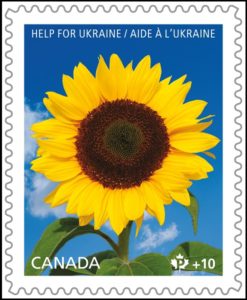
This semi-postal fundraising issue offers Canadians an opportunity to support Ukrainians affected by the current humanitarian crisis. Canada and Ukraine share a historic bond. The first wave of Ukrainian immigrants began to arrive in the 1890s, and Canada was the first Western country to recognize Ukraine’s independence in 1991. Today, nearly four percent of Canadians can trace their roots to Ukraine.
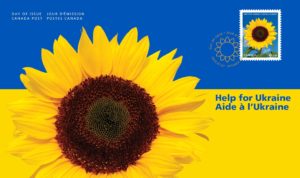
Stamp Value: Permanent™ domestic rate plus the 10-cent surcharge on each stamp; Stamp Designer: Hélène L’Heureux; Quantity Produced 500,000; Issue Date: July 7, 2022. This Official First Day Cover is being sold in support of Ukraine. A donation of 10 cents from the purchase of each Official First Day Cover will go directly to the Canada-Ukraine Foundation to provide much-needed financial assistance – and hope. The Official First Day Cover design features a sunflower – the national flower of Ukraine. It has become a symbol of peace and unity. The bright yellow flower, which has deep meaning for Ukrainians, can be seen throughout the country, including as adornment in the vinok, the traditional floral headdress. The sunflower is layered on top of the country’s yellow and blue flag. The cancel location for this stamp issue is Ottawa, Ontario. Quantity Produced 7,000.


2022 … Proof Silver Dollar –
The Platinum Jubilee of Her Majesty Queen Elizabeth II
www.mint.ca
When Her Majesty Queen Elizabeth II began her reign in 1952, the 25-year-old monarch could not have known the kinds of challenges Canada and the world would face, or how much progress she would witness. In many ways, the Queen of Canada came of age alongside this nation, embracing new and exciting developments, and adjusting to an ever-changing world with grace and dignity. Now, as Canada celebrates the Platinum Jubilee of Her Majesty Queen Elizabeth II, this special edition proof silver dollar reflects upon the journey of our modern monarch and celebrates her 70 years of service.
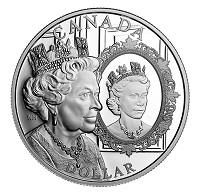
Face value: 1 dollar … Composition: 99.99% pure silver;
Mintage: 25,000; Finish: Proof; Weight: 23.17g;
Diameter: 36.07 mm; Edge: serrated; Certificate: serialized;
Artist: Neil Hamelin (reverse), Susanna Blunt (obverse).
Design: Designed by artist Neil Hamelin, your proof silver dollar’s reverse features a double portrait of Her Majesty Queen Elizabeth II to mark the historic occasion of her Platinum Jubilee. In the foreground, Her Majesty is presented in a three-quarter view and radiates wisdom gained through her 70-year reign. Next to her is a portrait of her younger self in 1952, shortly after her accession to the throne; the ornate frame includes several maple leaves that serve as an additional tribute to the Queen of Canada. The obverse features the date “2022” and the effigy of Her Majesty Queen Elizabeth II by Susanna Blunt.
Did You Know? ***Her Majesty succeeded to the throne on February 6, 1952, on the death of her father, King George VI. The 25-year-old princess-turned-Queen was visiting Kenya at the time, making her the first British monarch in more than 200 years to ascend to the throne while abroad. ***Her Majesty was crowned on June 2, 1953, at Westminster Abbey, the site of every British coronation service since 1066. Her Majesty’s coronation was the first to be televised worldwide and was seen by millions. ***On your coin’s reverse, both portraits of Her Majesty feature the George IV State Diadem, which can be seen on the obverse of Canadian coins issued between 1990 and 2002. This crown is most famously associated with Her Majesty, who wore it on Coronation Day and continues to wear it on State occasions, including the State Opening of Parliament.


2022 … Pure Silver Glow-in-the-Dark Coin –
Signs of the Zodiac
www.mint.ca
What’s your sign? The 12 signs of the zodiac (and their corresponding glyphs) each occupy a 30-degree section of the night sky on this 2 oz. fine silver keepsake. On your coin’s reverse, metallic colour adds a spellbinding shimmer to the deep hues and engraved illustrations that capture the mystery and allure of the zodiac. The 12 zodiac symbols are all derived from the constellations, the stars that form a belt across both the heavens and this coin, where the celestial patterns remain hidden until viewed under a black light (included).
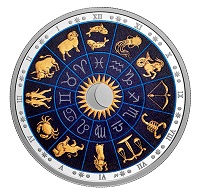
Face value: 30 dollars … Composition: 99.99% pure silver enhanced with colour, a metallic colour effect and glow-in-the-dark (black light) technology; Mintage: 4,000; Finish: proof; Weight: 62.69 g; Diameter: 50mm; Edge: serrated; Certificate: serialized; Artist: Jori van der Linde (reverse), Susanna Blunt (obverse).
Design: ***Enhanced with metallic colour, your coin’s reverse features a zodiac wheel designed by artist Jori van der Linde. This celestial circle is divided into 12 30-degree sections that house each of the 12 signs of the zodiac; these are arranged in a counter-clockwise direction, as indicated by the roman numerals on the outer ring: Aries (“I”), Taurus (“II”), Gemini (“III”), Cancer (“IV”), Leo (“V”), Virgo (“VI”), Libra (“VII”), Scorpio (“VIII”), Sagittarius (“IX”), Capricorn (“X”), Aquarius (“XI”) and Pisces (“XII”). Each zodiac sign is paired with its corresponding glyph, and together, these 12 glyphs form an inner ring that surrounds the combined sun and moon motif at the centre of the wheel. When viewed under a black light, the 12 zodiac constellations appear in the inner ring. The obverse features a field pattern and the effigy of Her Majesty Queen Elizabeth II by Susanna Blunt.

2022 … Pure Silver Gold-Plated Coin –
Black and Gold: The Sea Otter
www.mint.ca
A sea otter portrait that strikes a balance between gold and black rhodium plating. The third Black and Gold coin! One of the things nature does best is balance, and the sea otter is the perfect example: this adorable creature works hard, but it also makes time to float arm-in-arm (or paw-in-paw) with a loved one. Once hunted to the point of extinction, the sea otter has been reintroduced to British Columbia’s coastal waters, where its appetite keeps sea urchin populations in check—this, in turn, helps to restore and protect the kelp forests that are critical habitat for hundreds of species. It’s all about balance, which is beautifully represented on this coin’s dual-plated reverse.
Dynamic design … Like 2020’s The Canadian Horse and 2021’s The Grey Wolf, this coin’s reverse design is inspired by the yin yang symbol. No matter which way you view the design, you’ll always get a full glimpse of an adorable sea otter floating on its back. Black and gold rhodium … Yellow gold and black rhodium plating divide this coin’s design into two opposing but complementary elements. It is an inspiring representation of an industrious yet playful Canadian species, one that was hunted to extinction but is now mounting a comeback after its reintroduction to the coast of British Columbia. Matte proof finish … Just like previous Black and Gold coins, the black rhodium-plated portion of the reverse design features a matte gunmetal finish that strikes a dramatic contrast next to the yellow gold. It’s our way of playing with light and shadows to bring out details that are otherwise unseen in the other half of the design (and vice versa).
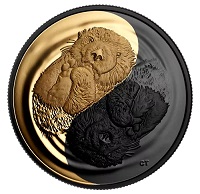
Face value: 20 dollars … Composition: 99.99% pure silver
with yellow gold and black rhodium plating,
Embellishments Plating; Mintage: 6,500;
Finish: Matte Proof; Weight: 31.39g; Diameter: 38 mm;
Edge: serrated; Artist: Claude Thivierge (reverse),
Susanna Blunt (obverse).
Did You Know? … ***Sea otters love to float on their backs while resting and eating! They’ll hold hands or wrap themselves in kelp to keep from drifting away while sleeping. ***Without sea otters, herds of sea urchins are known to destroy kelp forests at a rate of 9 metres per month. Kelp forests provide critical habitat for over 150 different species and ample prey for the sea otter, which needs to eat about 25 percent of its body weight daily. But its recovery on the B.C. coast has had some unintended consequences, too: its voracious appetite has negatively impacted Indigenous coastal communities and fishers who have traditionally relied on shellfish harvesting.
The circular reverse design by wildlife artist Claude Thivierge features a contrasting “yin and yang” portrait of the sea otter (Enhydra lutris). Two adult sea otters are positioned in a way that represents opposite but complementary concepts, such as work and rest/play. Yellow gold and black rhodium plating clearly divide the design into two halves in order to highlight the importance of achieving balance in life, but also in nature, where the sea otter’s reintroduction to Canada’s Pacific coast has had a big impact on the marine ecosystem. The obverse features the gold-plated effigy of Her Majesty Queen Elizabeth II by Susanna Blunt.
Claude Thivierge, Artist … For yin yang, this otter is ideal because it can be playful, dynamic, and calm at the same time. I wanted the artwork to reflect this energy. I want it to be dynamic with movement and a certain tenderness and beauty in her eyes and her endearing friendly way. It also gives us the impression that the otter is lying down, floating on its back, which is the case because it spends a lot of time in this position resting, eating, sleeping, and grooming.


2022 … Pure Gold Coin – Everlasting Maple Leaf
www.mint.ca
Canada is one of only two countries in the world that is bordered by three different oceans, and we’re proud of our extensive coastline. Each of those bordering oceans—the Arctic, Atlantic, and Pacific—is represented by a maple leaf on this gleaming collectible. It marks the return of the 1/20 oz. size, which is one of the most affordable ways to add a 99.99% pure gold coin to your growing collection.
Celebrate Canada’s oceans … Nothing says “Canada” like the proud maple leaf. Your coin features a classically styled and superbly engraved portrait of maple leaves in their natural state—an inspiring image that has deeper meaning since the leaves represent Canada’s three bordering oceans. Reverse proof finish … Your coin features a reverse proof finish, with a frosted field that contrasts against the mirror-like shine of the engraved relief. Unique size … Slightly smaller than a dime, this is one of the few 1/20 ozs. collector coins that have been minted by the Mint as a stand-alone collectible—the size is usually reserved for bullion products and fractional sets.

Face value: 10 dollars … Composition: 99.99% pure gold;
Mintage: 5,000; Finish: Reverse Proof; Weight: 1.58g;
Diameter: 14 mm; Edge: serrated; Certificate: serialized;
Artist: Michelle Grant (reverse), Susanna Blunt (obverse).
Did You Know? … ***Canada has the world’s longest coastline (total length of 243,042 kilometres) whereas the Arctic coastline runs around 162,000 kilometres in length. ***The maple leaf is tied to some of Canada’s proudest achievements. Its first recorded use as a Canadian cultural symbol dates back to 1836 when the Société Saint-Jean-Baptiste adopted the maple leaf as its emblem. Today, it is one of the most famous emblems of Canada—you’ll find it on our coins, stamps, military badges, coat of arms, and of course, our flag!
Designed by Canadian artist Michelle Grant, your coin’s reverse features an inspiring arrangement of sugar maple (Acer saccharum) leaves that symbolize Canada’s three bordering oceans: Arctic, Atlantic, and Pacific. The obverse features the effigy of Her Majesty Queen Elizabeth II by Susanna Blunt. Michelle Grant, Artist … Canada has the unique good fortune to have its lands touched upon by three different oceans. These three sugar maple leaves represent each of those Canadian shores, illustrated with a subtle rhythmic wave to them, like the swells of the oceans. The three elements are repeated again within the natural three-lobe structure of the sugar maple leaf.


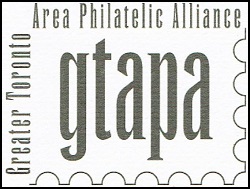
www.gtapa.org
The GTAPA is committed to promote and stimulate
the art of philately to all ages for fun,
culture, education, and friendship.




